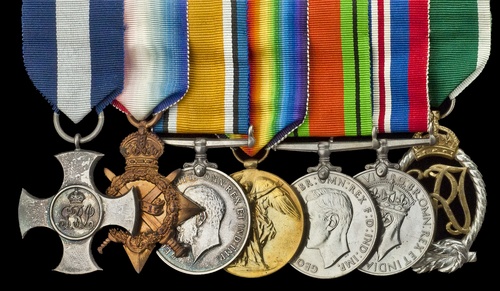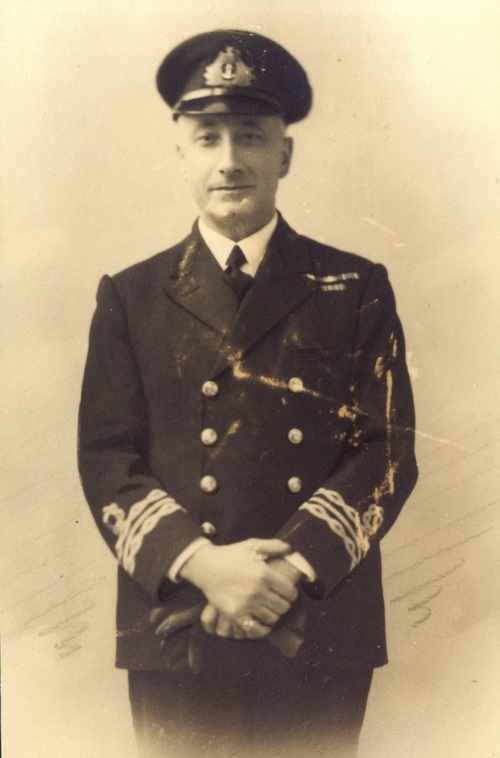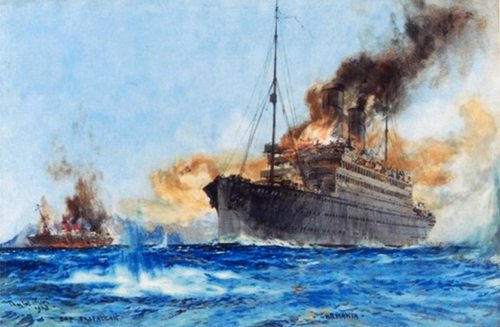Auction: 16003 - Orders, Decorations, Campaign Medals and Militaria
Lot: 10
SOLD BY ORDER OF THE RECIPIENT'S GRANDSON
The Fine and Scarce 1914 D.S.C. Group of Seven to Lieutenant Commander G.F. Dickens, Royal Naval Reserve, for the Epic Engagement Between the 'Carmania' and the 'Cap Trafalgar' Off Trinidad, 14.9.1914
a) Distinguished Service Cross, G.V.R., silver (Hallmarks for London 1914), unnamed as issued
b) 1914-15 Star (Lieut. G.F. Dicken. R.N.R.)
c) British War and Victory Medals (Lieut. G.F. Dickens. R.N.R.)
d) Defence and War Medals
e) Royal Naval Reserve Decoration, G.VI.R., silver and silver-gilt, reverse officially dated '1941', note surname to first, otherwise good very fine, mounted as worn, housed within a glazed wooden box, together with the following related material:
-The Great War miniature awards
- The recipient's Naval Officer's peak hat
- Original Naval charts for the English Channel, from H.M.S. Carmania, used and dated at issue '9.Aug.1912'
- A copied portrait photograph of the recipient
- Two photographs of ship scenes (Lot)
D.S.C. London Gazette 10.4.1915 Acting Sub Lieutenant George Frederick Dickens, R.N.R.
'For services in the action between H.M.S. "Carmania" and the German Armed Merchant Cruiser "Cap Trafalgar," on 14th September, 1914, when the latter vessel was sunk.'
R.D. London Gazette 10.2.1942 Lt.-Cdr. George Frederick Dickens, D.S.C., R.N.R. (Retd.)
Lieutenant Commander George Frederick Dickens, D.S.C., R.D., born Pill, Somerset, November 1891; joined the Royal Navy as a Cadet, 1907; appointed Midshipman, Royal Naval Reserve, 4.9.1909; served during the Great War, commencing his service aboard Carmania; advanced Sub-Lieutenant (Acting Lieutenant), 8.9.1915; Lieutenant, 8.9.1917; Lieutenant Commander (Retired), 8.9.1925; mobilised as Lieutenant-Commander, 3.9.1939, serving throughout the War principally engaged in the fitting of defensive equipment for merchant ships; died, Weston-Super-Mare, Somerset, July 1965.
A D.S.C. Aboard The Burning Bridge
Upon the commencement of the Great War, following the initial Naval engagement at Heligoland Bight, 28.9.1914 innumerous armed merchant cruiser vessels were armed and tasked with engagement with the new enemy.
On the morning of 4.9.1914, the German liner Cap Trafalgar was coaling off the western coast of Trinidad. In the previous weeks, she had been lying in the River Plate and cruised out 1.9.1914 to meet the German gunboat Eber. In the process the Cap Trafalgar acquired a number of naval ratings, two 4.1 inch guns and six pom-poms, with the object of utilising such a suitable vessel for engaging and raiding merchant vessels. The H.M.S. Carmania, under command of Captain N. Grant, R.N. spotted and closed with the Cap Trafalgar, which surprised, began to turn and cruise away at great speed. However, its course was altered, bringing the two vessels closer to initiate the engagement, which began at 5,700 yards. The initial volleys from the Cap Trafalgar were aimed too high, with the Carmania scoring a number of hits to the hull. However, with the vessels drawing closer Cap Trafalgar soon begun to score, setting the bridge of Carmania alight and rupturing her main water pipe, ending any hopes of dampening the blaze. For a full one hundred minutes, the two vessels exchanged, with the Cap Trafalgar eventually becoming heavily ablaze and laying especially low in the water, destined to sink. Her final movement was an escape, however the damage and fires were too severe, the vessel capsizing to port and sinking at the head.
Whilst five boats soon arrived at the scene to collect survivors, the Carmania was in no state to assist. The fires continued to rage and eventually her bridge was abandoned, together with the loss of most the essential instruments. An article in the London Times, 26.9.1919 gives further information to the noble engagement which the two luxury liners entered.
'Carmania and Cap Trafalgar. New light on the duel
Interesting and hitherto unpublished details of the victorious action of the Cunard liner Carmania with the German armed merchant cruiser Cap Trafalgar were revealed in a letter from Captain Noel Grant, R.N., which was read at a function on board the Carmania at Liverpool on Sunday. The letter, which was read by Sir Thomas Royden, M.P., deputy chairman of the company, paid a tribute to the efficient commissioning of the Carmania under Captain Barr. It was said to be entirely owing to the very efficient way in which the ship was stripped of all woodwork between decks that they were able to reach port after the action. " If we had gone to sea," said the letter, "with the cabins standing, as some of the armed merchant cruisers from other ports did, the ship must have been burned out. I can safely say that I have never sailed with a better or keener ship's company. Captain Barr was of the greatest assistance to me during the action, and it is due to his initiative and resource that the fire below the bridge did not extend to the next deck. When I first looked round after the action, I found we were in a very uncomfortable position of having no effective compass, no charts, no chronometer or sextant, and no secret wireless code. The ship had to be steered from the after lower position, the only communication from deck being by a relay of men to pass the word down. There were no engine-room telegraphists, so orders had to be passed down the engine-room skylight by blasts of a mouth whistle. "I afterwards found that two midshipmen - Coulson, who, I am sorry to say, was later in the war killed in a submarine, and Dickens - had gone on to the burning bridge and, at great personal risk, got the bowl of the standard compass, some charts, and the remains of the much-burned wireless code. A sextant was found in a cabin between decks, so that by fixing the compass on a long pole, deadening the vibration by placing it on a feather pillow, we were able to steer a moderately correct course and were very pleased to find our signalled position was correct enough to enable the Bristol to pick us up the next morning and escort us to a safe anchorage, where we met our ships ; and with their help we were able to make the ship seaworthy for the cross-Atlantic trip to Gibraltar. This action was the only one throughout the war in which an equal, or, as a matter of fact, a slightly inferior force annihilated the superior force. My contention that we were the inferior force is based on the fact that the Cap Trafalgar was the faster ship and her guns outranged ours by 2,000 yards. I am therefore thankful that the German captain came in towards me and put up a perfectly fair fight instead of taking advantage of these two great assets in a naval action. Later a piece of silver plate, formerly the property of Admiral Lord Nelson, was presented by Mr. McLean, of the Navy League, supported by Admiral Fremantle, to the Cunard Company in recognition of the Carmania's victory.'
Dickens's gallantry is noted further in the Commander H. Spencer-Cooper's work of 1980, The Battle of the Falkland Islands: Before and After 'The Action of H.M.S. Carmania...Acting Sub-Lieutenant G.F. Dickens, Royal Naval Reserve, awarded the D.S.C. saved vital parts of the Standard Compass when the bridge was abandoned, and then assisted in saving the charts.'
The ferocity of the engagement is stark, with Carmania being struck with 79 projectiles and suffering 9 casualties and 26 wounded. Upon the conclusion of the Great War, this engagement resulted as the longest 'single', with one historian commenting, 'No single ship has been fought to the death in such a historic and Nelsonian fashion.'
Three D.S.C.'s, together with two C.B.'s, one D.S.O and twelve D.S.M.'s awarded for this action.
Subject to 20% VAT on Buyer’s Premium. For more information please view Terms and Conditions for Buyers.
Estimate
£6,000 to £8,000









